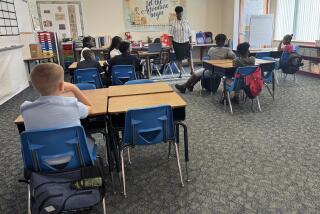School Casts New Light on Learning : Education: Some students find that with fewer social pressures they can focus more on their studies at Washington stateâs only evening high school, the model for a similar Glendale project.
LACEY, Wash. â Dusk falls slowly near the southern tip of Puget Sound. But the 230 students of New Century High seem hardly to notice as they sit through lessons well into the night.
At the only evening high school in Washington state, classes begin at 2:30 p.m. and end at 8:40 p.m. And students like it that way--from the aspiring obstetrician who wakes before dawn to go to work to the longhaired Led Zeppelin fan who sleeps until afternoon.
What binds them is a need for a small learning environment that enables them to know all their teachers and schoolmates, and a strong dislike of the social pressures that pervade traditional high schools.
âKids just seem to blossom there,â said Paula Gilpin, whose daughter is a sophomore. âItâs mainly for the middle-of-the-road kids who are not failures and not hotshots. Itâs mainly for the middle-of-the-road kids who suddenly come into their own. Thereâs not all the pressure from cheerleaders, football players, hoodlums and all.â
Respected within educational circles for its success in motivating students, New Century is the model the Glendale Unified School District has selected as it develops its own evening high school.
Glendale trustees voted in July to become the first California public school system to provide comprehensive classes next fall for regular high school students in the late afternoon and evening.
Keeping campuses open longer is one way for financially strapped districts like Glendaleâs to ease overcrowding and curb dropout rates, while saving money and avoiding unpopular year-round class schedules.
Many in Washington state--including parents, teachers and the state superintendent of public instruction--say certain teen-agers benefit tremendously from nighttime instruction, staying in school when they might otherwise drop out.
But after five years, support for New Century is far from universal. Teachers and administrators at other campuses believe that the institution drains resources away from their schools. Friction abounds between the staffs--and students--of the two schools that share, day and night, the same specially designed campus. Critics claim New Century has become elitist.
The difficulties have been exacerbated by tight finances. A proposed tax increase for teachersâ salaries, classroom supplies and extracurricular activities failed in February and April, triggering more than 100 layoffs in the district. If voters reject the tax increase again early next year, closure of one of the daytime high schools, and possibly New Century, will follow, officials said.
But few in this bedroom community of 24,280 near the state capital of Olympia deny that evening high schools in general are a good idea.
Most New Century students say they adjust well by doing homework before or after school, and spending more time with friends and family on the weekend. One in four finishes work before school begins.
Student body President Valerie Reid said she was once an out-of-control hoodlum who first smoked pot at the age of 7 and enjoyed beating up strangers as a gang member.
The 17-year-old California native enrolled at New Century after her father walked into the wrong school office. He came out sold on the idea of an evening high school.
âIt was logical,â Reid says now. âI learned more at night because it was my prime time. . . . It was not like I hated school. At the time, it was like I had bigger and better things I could be doing.â
Fellow senior Aurora Laing dreams of becoming an obstetrician and wakes before dawn each day to work as a courtesy clerk at Safeway for up to five hours. Then, she returns home to do homework before going to classes.
Bubbly and serious at once, Laing is neither the homecoming queen type nor the class nerd, the kind of girl who admits she rarely got noticed by peers. âI have nothing against anybody, but I guess I never fit in,â she said.
Only after she broke down in tears did Laing persuade her father, John, that she might blend in at New Century.
âOriginally I thought of it as a dropout school, as an alternative high school,â he said. âI thought it was for kids with names like Bubba or Killer, street-type slang names. . . . But itâs for kids who donât want to be bothered with all the socializing.â
Surrounded by miles of evergreens, the 40-acre campus opened last year. It was specially built to accommodate two different high schools in much the same space. There are two sets of administrative offices.
The schools are a study in contrasts. Only in passing do students from either school acknowledge one another, and derisive remarks are often traded. In the 39 minutes it takes for the daytime students to leave the grounds before New Century opens, it is clear that the gulf between them is wide.
âThey keep to themselves and we keep to ourselves, and if they have anything to say to us, we ignore âem,â said Todd Porter, a New Century senior and self-described cowboy fond of wearing Stetsons.
At River Ridge, the daytime high school that shares facilities with New Century, rap, hip-hop and R & B rule--baggy pants and sports jackets are in vogue. For many, popularity can be measured by how many varsity sports you play.
New Centuryâs dress code is come-as-you-are, no one really cares. While most students look like typical teen-agers, others resemble a blast from the past with long, unkempt hair, tie-dye shirts and sandals. The closest many ever get to physical exercise is playing intramural sports in street clothes.
The student councils of both schools have met regularly, but efforts to bring other students together have failed. âWeâve talked about having a joint school dance,â said Georgia Cutburth, a co-director for River Ridge, âbut our kids like hip-hop and rap and theirs like the moshing pitsâ used by slam dancers.
Some River Ridge students mercilessly use words such as geeks, freaks and losers to describe their nighttime counterparts.
âI think our students sometimes experience discrimination for being who they are: individuals,â said New Centuryâs principal, Gail Covington-McBride.
âEven though there are some detractors out there, within this environment it doesnât touch our students,â she said. âStudents find acceptance here among their peers. Does it hurt me when people say derogatory things about our students? Yeah.â
McBride boasts that 64% of her students eventually go on to college. And the schoolâs average scores on standardized tests rank just above the district average, though some say that is because the sample is taken from a smaller student population.
Its sister school is five times larger than New Century, with about 1,200 students and the districtâs highest minority population, 31%. New Century has the fewest minorities, less than 10%.
Teachers say they joined New Century for the intimate learning atmosphere, though the student-teacher ratio is about the same as elsewhere in the district: 24 to 1.
When the program was first conceived, Supt. David Steele said, the district suffered from overcrowding and was struggling to find ways of serving students with late-night jobs who often dropped out. Not enough room was left for portable classrooms on high school campuses, and year-round schooling was not a popular option, he said.
âWe didnât want this for kids in trouble. We looked very seriously at these bright kids who didnât fit into a traditional schedule,â Steele said.
The superintendent said his 13,000-student district should have avoided creating a single campus shared by two high schools with separate identities, principals and staff.
âGlendale needs to look very carefully at, rather than having two distinct schools on one campus, how to use a campus for a longer period of time,â he said.
The faculties âfought all the time,â Steele said. â âWhoâs using the room? Why are you invading my space? Someoneâs using my stuff.â â
For parents, the biggest concern was whether students would be safe at school and in the neighborhood at night--a worry similarly shared in Glendale, where the school system is more than twice as large.
But it has been the classroom success that has won high praise from state officials and a Blue Ribbon Award from the U.S. Department of Education last year.
âOne of the things weâve begun to recognize is that all students donât learn the same way,â said the Washington state superintendent of public schools, Judith Billings.
âThe fact Iâm looking at in this case is there are a lot of students who would have otherwise opted not to go to school and are staying in school,â she said. âThere is a commitment to learning here that is probably greater than what you would find in a regular high school setting.â
More to Read
Sign up for Essential California
The most important California stories and recommendations in your inbox every morning.
You may occasionally receive promotional content from the Los Angeles Times.










